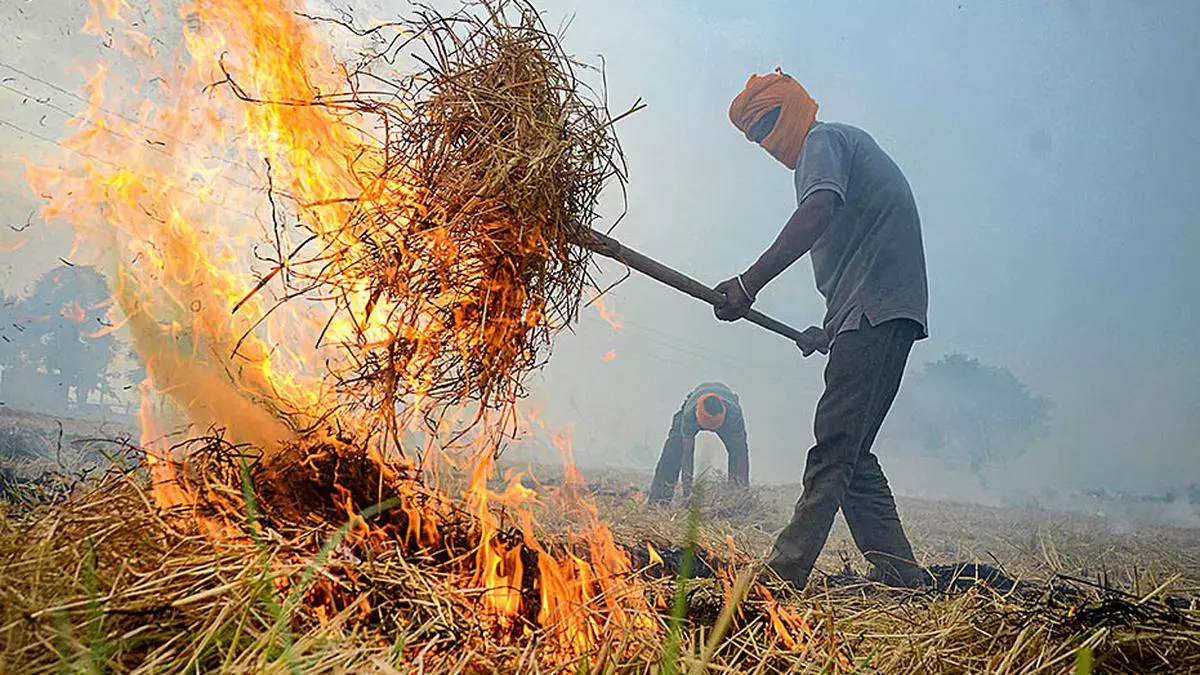Turning waste into wealth: Innovative solutions to combat paddy straw burning
India can set an example for the world by being innovative in using its agricultural waste. The burning of paddy straw in India is a practice often used to clear fields for rabi crop sowing in the States of Punjab, Haryana and Uttar Pradesh. Due to the short time period between harvesting and sowing, farmers often choose burning paddy straw as the quickest method for residue management. An estimated 8.9 million tonnes of paddy straw are still being burned in Punjab, Haryana, and the scale of burning in Punjab is more severe as around 7.3 million tonnes have been burned alone in Punjab. This poses significant environmental concerns, including air pollution, greenhouse gas emissions and soil degradation.
- Also read: Tackling stubble burning
Burning 1 tonne of paddy straw releases 1,460 kg CO2, 60 kg CO, 3 kg particulate matter, 199 kg ash, and 2 kg SO2, along with 0.7–4.1 kg of methane and NO2 in minute amounts, which are potent greenhouse gases. This severely degrades the air quality, as evidenced by the high AQI in the national capital during November and December, while also contributing to global warming in the long term. Soil also suffers significantly as burning negatively affects pH, moisture, organic matter and the available phosphorus content of the soil. Utilising paddy straw as a value-added product instead of burning it has multiple benefits for the environment, economy, and society.
Here are some ways in which paddy straw can be utilised as an alternative:
Bioenergy Production: Paddy straw can be used to generate bioenergy through processes such as biomass gasification, pyrolysis, and biogas production. This can help reduce the reliance on fossil fuels and mitigate greenhouse gas emissions. Paddy straw can be utilised for anaerobic digestion, which produces valuable biogas that can be purified and used as CNG and PNG in the city gas distribution networks. There is a CBG (compressed biogas) plant based on paddy straw in Sangrur, Punjab. With the amount of straw burned in the north-western States of India, we can produce more than ₹270 crore of renewable gas.
Ethanol production
Bioethanol production: Paddy straw contains up to 40 per cent cellulose. The cellulose in paddy straw can be used for ethanol production, as microorganisms like S. cerevisiae can convert the cellulose into ethanol. This bioethanol is an excellent biofuel, and as per the government of India’s roadmap for ethanol blending by 2020–25, up to 20 per cent ethanol can be blended into petrol by 2025–26. The amount of ethanol that can be produced from paddy straw would be worth ₹1,600 crore, a direct saving to the government.
Lignin: Paddy straw also contains up to 20 per cent lignin, which is a sustainable resource for a variety of products such as polymers, mixed phenols, mixed aromatic alcohols, mixed organic acids, mixed hydrocarbons, mixed quinones, mixed benzylic aldehydes, aromatic pyrolysis oil, alkyl benzenes, carbon fibres, and activated carbon. Lignin-derived materials and fuels can be both sustainable and economical, with potential applications like activated carbons, resins, carbon fibres, nanoparticle synthesis, photovoltaic cell development, adsorption of heavy metal ions in water, water flocculation, etc.
Paper and Pulp Industry: Paddy straw, along with wheat straw, can be used as a raw material in the paper and pulp industry. It can help reduce the demand for wood-based pulp, conserving forests and biodiversity. This will help us further protect the environment and reduce health risks for human beings. As a general rule of thumb, it is estimated that approximately 1.5 to 2 tonnes of rice straw are needed to produce one tonne of pulp, which may vary as per paper quality. This means that to completely replace wood in the global paper industry, approximately 200 to 250 million tonnes of rice straw would be needed annually.
Cost savings
Building materials and composites: Paddy straw can be used in the production of eco-friendly building materials such as straw bales for construction. This can promote sustainable and energy-efficient housing solutions. Biodegradable composites of several types can be created using paddy straw in conjunction with various polymers to create biodegradable sheets, acoustic pads, etc. India has been using paddy straw and other natural fibres as reinforcements in mud houses for centuries. Straw-based roofs are low-weight, breathable, and water-resistant and serve as a low-cost alternative to asbestos, concrete, and GI sheets. Utilising paddy straw in alternative and innovative ways is the need of the hour, as it will help with air pollution and greenhouse gas emissions, the preservation of soil fertility, and the conservation of natural resources like forests.
In addition, it will lead to diversification of income sources for farmers, cost savings due to reduced reliance on fossil fuels and chemical inputs, the creation of new industries and jobs and the development of rural economies. However, the socioeconomic impact of alternative usage of paddy straw in India and worldwide depends on various factors, including government policies, technology adoption, and market demand. Successful implementation would require investment in research, infrastructure and farmer education. It could lead to improved livelihoods, reduced environmental degradation, and increased food and energy security, which are critical aspects of sustainable development.
(The author is Chairman, Indian Biogas Association)
